Olympus E-520: Update to a Top Seller
by Wesley Fink on August 26, 2008 3:00 AM EST- Posted in
- Digital Camera
Field Notes
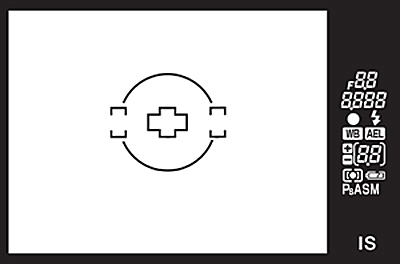
The biggest disappointment from our perspective was Olympus' decision to continue the 3-point AF module of previous Olympus models. The E-520 does seem to be a bit faster in AF, but it is not really competitive in the number of sensors, AF speed, or tracking abilities with the Canon XS or Sony A300. The E-520 is so competent in other areas that we are left to wonder why Olympus did not bring some version of the E-3 AF technology to the updated E-520. Similarly the viewfinder remains far too tunnel-like, which is saying quite a lot in a class of entry-level DSLR APS-C cameras - none of which is particularly outstanding in the viewfinder department. The more expensive Canon XSi and cheaper Sony A200 both have better viewfinders than any of these entry models do.
Olympus has also continued the viewfinder info display on the right side of the viewfinder. Since the 4/3 cameras feature a narrower frame than the 3:2 cameras that mimic the 35mm format (every other camera in this class), there is certainly extra room on the side. However, the tunnel view makes it difficult to see info on the side without adjusting your eye side to side. A larger image magnification closer to the 1.10 on the E-3 and info below the viewfinder would better suit us.
Image Quality: Olympus seems to have borrowed most from the image processing capabilities of the E-3, which is a very good thing. The E-520 is much improved in controlling noise over the E-510 it replaces. Images to ISO 800 are very good and ISO 1600 is now more like the excellent E-3. The E-3 is subjectively one of the most accurate cameras in reproducing color that we have tested, and the E-520 is now much closer in image quality to the E-3. Take a close look at the image noise comparison with the E-3 on page 7.
Customization: The menus are complex, but that is mostly because you can customize almost anything on the E-520. It is without doubt the most flexible entry-level DSLR among the group detailed on page 3. The Canon XS does not even have a real spot metering capability, where the E-520 has three spot modes - normal, highlight, and shadow. Almost every button can be reassigned if you choose. There is no easily accessible auto focus to manual focus switch, but you won't really miss it. Just choose the AF+MF modes and after pushing the right "AF" button in the joy-pad and you gain the ability to manually focus any lens to touch up the AF selected focus - without any special buttons or procedures. This is like making every lens a ring USM motor on a Canon, which the kit lens for the XS/XSi certainly is not.
Ease of Use: Some have criticized the complexity of the Olympus E-520 menus, but it is our opinion that the real issue is that Olympus takes a different approach to menu logic than Canon and Nikon. The E-520 menus will be instantly comfortable to any former Olympus user. If you are not used to Canon or Nikon already the menu logic will quickly make sense to you.
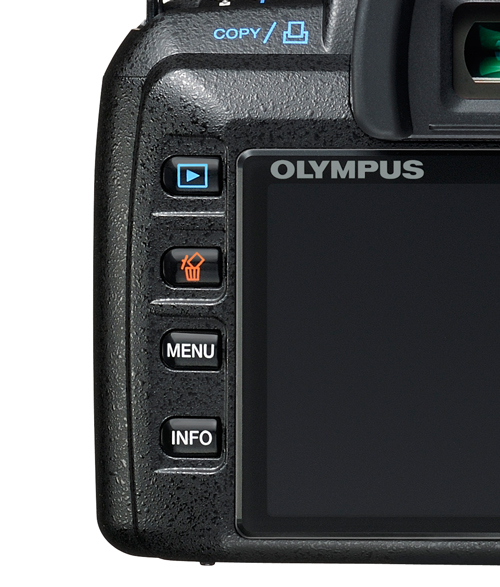
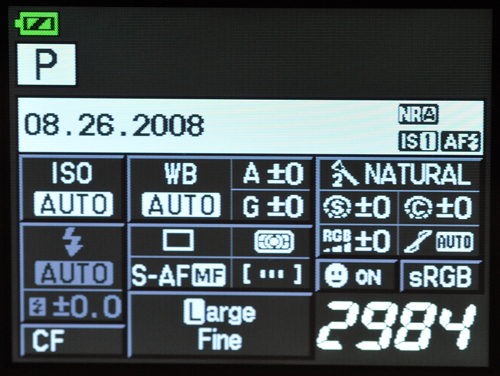
New users, expert users and even those who don't like the menus can work completely from the Info screen. Click the Info button at the lower left of the screen. Hit OK and use the joy pad to move around the Info screen until you find what you want to adjust. Press OK again to move into adjusting the selected parameter, move to your choice with the arrow keys, and press OK to select.
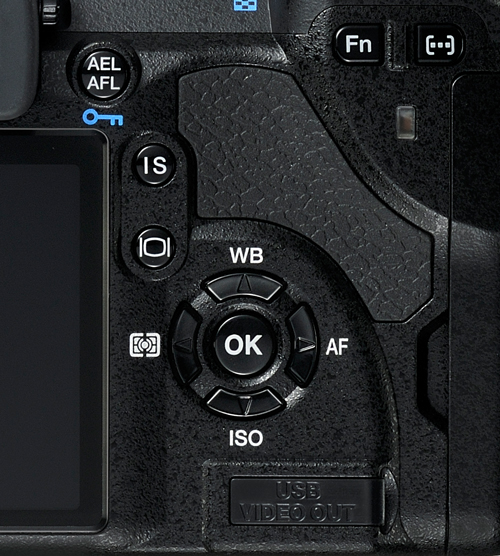
You can also instantly select ISO, metering mode, White Balance, or AF Mode by pressing any of those labeled keys at the four direction points on the joy pad. There are also IS and Live View buttons for those options.
Olympus provides more adjustments and more customization that any comparable entry camera. Many users will appreciate that feature. If the menus are intimidating, stick to the buttons and Info menu. They are easy for anyone to use.
Handling: Perhaps this should be called ergonomics, but considering how small the E-520 actually is, it is much easier to handle than the similarly small Canon XS/XSi or Nikon D60. The wider, less tall form factor made holding the E-520 easier for us. However, the Canon XSi/XS with a battery grip takes those cameras into a new category as handling improves dramatically. The E-520 and Nikon D60 lack a battery grip option. As a camera alone, the E-520 handles best. The Sony A200/A300/A350 and Pentax K200D are larger and heavier cameras. Those who find the Canon, Nikon, or Olympus entry cameras too small may prefer the Sony or Pentax.
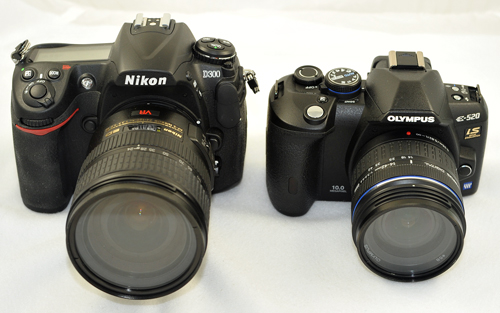
Size and Weight: This is a picture of the E-520 next to the popular Nikon D300 APS-C prosumer model with a 24-120mm VR lens. This is to illustrate how incredibly small the E-520 really is.

The E-520 is also available as a two-lens kit with the very small 40-150mm (80-300MM) lens. These two lenses cover the 35mm equivalent of 28-300mm in two tiny lenses that are highly regarded for their optical quality. Those who complain that 4/3 isn't really smaller need to examine an E-520 two-lens kit beside similar offerings from any other camera maker. If you want to pocket the E-520 or E-420, you can choose the tiny 25mm (50mm equivalent) f2.8 pancake lens.










12 Comments
View All Comments
illusionist - Wednesday, August 27, 2008 - link
Is it just me or ya'll get the feeling that this place is owned/heavily sponsored by nvidia?Rev1 - Wednesday, August 27, 2008 - link
Is it me or was the reply completely irrelevant to the review here?teldar - Wednesday, August 27, 2008 - link
Sounds like it may be interesting.I have to say that I would really like the new Pentax k20 when I graduate, but the new lenses for them start around $600. To get a 2 lens kit similar to what is available with this olympus, it's around $2300. I little on the pricey side for a definitely amateur photographer.
Maybe in the next year, Olympus will upgrade their autofocus one more time.
T
trisweb3 - Wednesday, August 27, 2008 - link
Disclaimer: I am an Olympus user and I like the cameras, but I try to keep very objective about camera brands as it doesn't help anyone to argue over them - just use what's best to you. Okay then.Wesley, AnandTech, I know you are not digital camera specialists and you're trying to give this a chance, and I appreciate the attention you're giving to alternative brands and other option, kudos there, but putting real trust in your reviews is somewhat difficult for me personally. There's a lot of speculation, missed points, incomplete understanding, and a general misconception of what's important and what's not in a digital camera.
For example (this was what really hit me in this review) the white balance preset for Tungsten light is absolutely 100% completely inconsequential to actual photography. It's meaningless, just use a different preset or set the white balance so white is white, every modern camera can do this, and it's no merit or demerit of any of these, yet it got a good three paragraphs of attention in the review.
Also, it may be important to you, but you lambaste the 3-point AF system as a true failing of the camera. While I find that's true if you use multi-point autofocus extensively, on every camera I've ever used, I just want the center point so I know where focus is going to go. It is certainly a limitation that people should know about, but it's not going to have the same importance to everyone else as it did to you. Not bad though, it's good to know.
The paragraph on Image Quality was entirely about noise - this is not the only aspect of the image that people care about. What about color balance and appearance? Highlight and shadow rendition? Dynamic range? I'd love to hear more depth to this important bit.
On the other hand, things about this camera that are truly important features were relatively ignored. What about in-camera image stabilization? Most people don't know how useful it is to have every lens stabilized. What about the dust-buster that really works, so you never have to clean the sensor?
On the positive side, it's great to see a review on a large site that really focuses on the amateur average user and brings everything to a good conclusion. It's nice to hear it from a "Well, here's what I thought of it, let me show you" perspective. Plus, it should also be telling that real users such as yourself actually enjoy using Olympus DSLRs. I know I have, and convincing people of the validity of the E-system is always a bit difficult.
So, keep it up, keep learning, try to stay objective, and try to focus on what's really important and don't worry too much about trivial details if you can avoid it. Thanks!
Wesley Fink - Wednesday, August 27, 2008 - link
Thank you for your reply, but I still disagree with your claim that focus points don't matter. If they truly don't matter then why does Olympus use 11 double-cross points (44 segments) in the E-3 and only 3 in the E-510. Why then, does Nikon use 51 points in their top cameras and only 3 in their D60, and why does Canon use more points as the price goes up?I do agree that the number of points really don't matter in thoughtful photography when you have the time and know what you're doing. However, in action, sports, or even photographing active kids the number of points and focus tracking definitely DOES matter. Try shooting sports or playing kids with a D300 compared to the E-520 and you will also be convinced. ANY kind of focus tracking is very difficult to impossible with just 3 points. Can you take great photos with just 3 points or even one point or none - of course you can, but that is not the point.
My point was that in a comparison to other cameras in its class the E-520 falls short in the AF module, and that does matter in the marketplace. Almost every other camera with which the E-520 competes has more AF points, better focus tracking, and faster AF, and that definitely DOES matter to many buyers.
In other areas like color accuracy Olympus does a very fine job. The E-3 AF is SO much better in AF that its a fair question as to why Olympus won't bring some of that technology to their new, lower-priced cameras. It would definitely make Olympus even more competitive.
I did overemphasize noise, as you point out. That was primarily because Nikon and Canon users often unfairly criticize Olympus for their noise as Inherently the case due to the smaller 4/3 sensor. The real size difference between 4/3 and Canon's 1.6X APS-C is fairly minimal and I was trying to put that concern to rest. Olympus has done a good job of bringing the excellent image processing and noise reduction from the E-3 to the E-520, and I believe it is important to show that to the rock-throwers.
As for white balance Tungsten performance on Auto WB and Tungsten presets I confess that is a pet peeve. If you only shoot outdoors or in a studio they really don't matter. However, amateurs shoot indoors without flash - which is one of the reasons they step up from a P&S. How an entry level camera handles indoor available-light shooting is VERY important, IMO, in evaluating a camera - particularly an entry-level camera.
Of course photographers and those who understand color temperatures and how to set up Custom White Balance can deal with poor Tungsten balance, but it still is very time consuming. For first time DSLR buyers, however, orange tinted photos are often a mystery. In case it wasn't clear the Olympus Tungsten preset did a pretty good job. Auto WB in tungsten lighting, however, was about as bad as Canon and Nikon. Actually Sony does the best job of handling Tungsten under Auto that I have seen in current DSLR cameras.
melgross - Thursday, August 28, 2008 - link
White balance settings don't matter at all if you're using RAW, in a proper converter. You can try setting a scene at any setting, and they will all become the same in the converter when the settings are changed there.But, when shooting JPEG, is sure does make a difference. Whatever setting is used determines the final quality. changing from one to the other can almost destroy the the image from a quality viewpoint.
So I agree that whitepoint settings are very important if you shoot JPEC, as many amateurs sadly do. but for RAW shooters, it doesn't matter at all.
I also agree that noise is very important. It determines the effective dynamic range of the camera.
Color accuracy is like white balance. Shoot RAW, and it isn't too important (esp. when a camera uses 14 bit conversion). But when shooting JPEGs it is.
trisweb3 - Wednesday, August 27, 2008 - link
Thanks for justifying all that, great response and I appreciate it.I wasn't arguing that focus points don't matter, I definitely see the value in having more and better of them, but I was just saying that it may not be as important to everyone as it is for you. But I've decided I sort of like your injection of opinion into reviews and while it's a different style than you usually see online, it's refreshing as well.
I'm a happy Olympus user and fan as well, so I'm well up on all the noise, sensor size, and competitive comparison issues that normally come up. Just playing a little devil's advocate to try to keep you thinking :) Thanks again.
pinto4402 - Wednesday, August 27, 2008 - link
Hey Wes,Keep up the good work. You bring a different perspective to camera reviews, and I appreciate it. I regularly read all the other review sites, but I actually look forward to your articles. Many reviewers tend to fetishize new technology for its own sake. You, on the other hand, actually evaluate whether a new technology is actually useful. Also, you take responsibility for your opinions as opposed to hiding behind statistics and "objective" tests which often times are quite useless to most photographers.
You're not going to please everyone. Your article style is definitely not typical, but that's okay because we need a different voice in the camera reviewing universe.
melgross - Wednesday, August 27, 2008 - link
Compared to what? Everything other than Canon and Nikon?The two together have almost 90% of all D-SLR sales. That leaves the other 10% or so to Sony, Olympus, Pentax, Sigma, Panasonic, Samsung, etc.
trisweb3 - Wednesday, August 27, 2008 - link
For Olympus, the E-510 and E-410, and now the -20 series, have certainly sold better than any previous models.Wish I had facts to back this up, but I can only go off what my local photo store tells me about the E-420/520 selling like hotcakes.
Obviously Canon/Nikon are still at the top, but the improvement is notable.